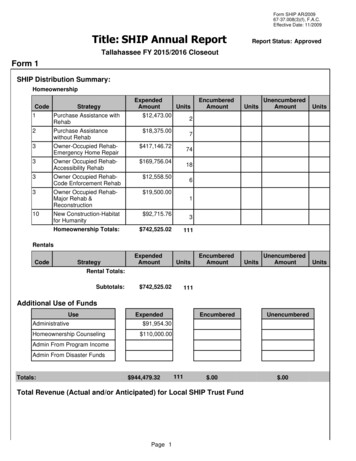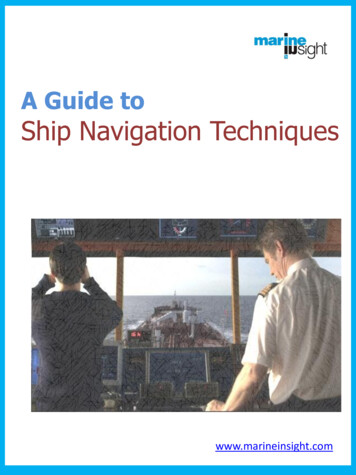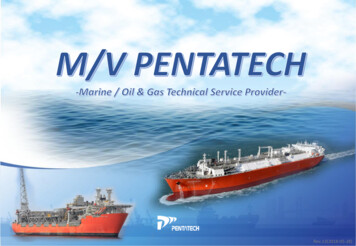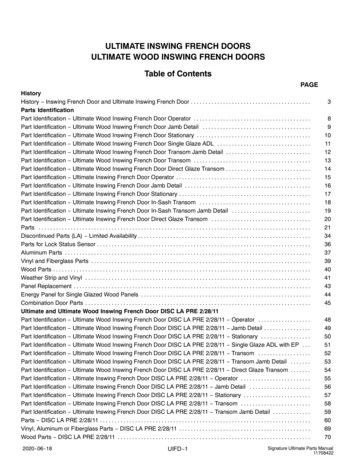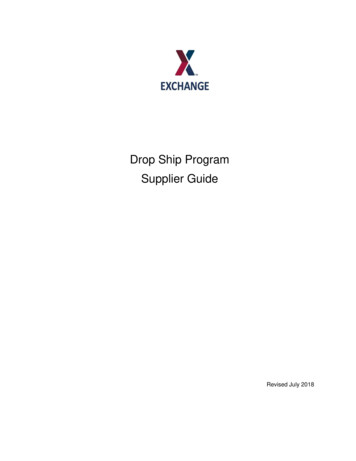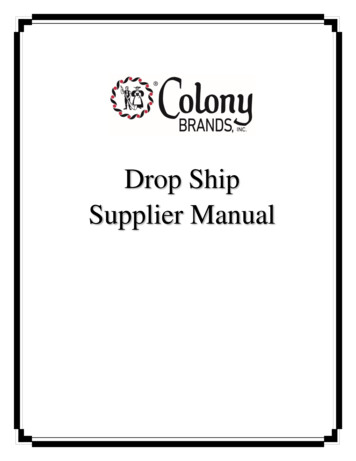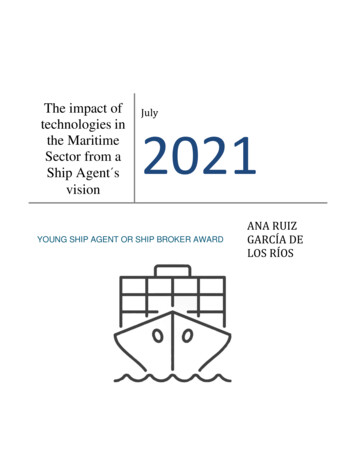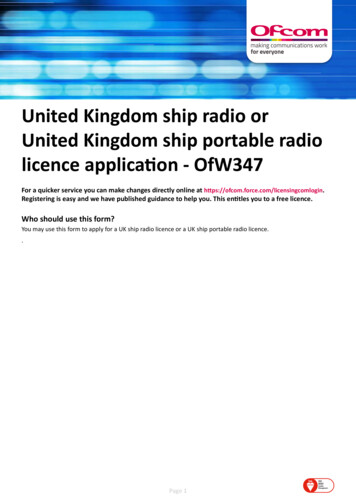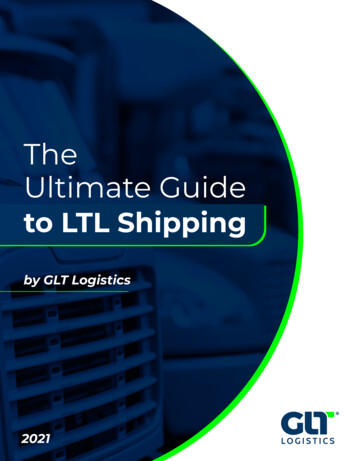
Transcription
TheUltimate Guideto LTL Shippingby GLT Logistics2021
Table of ContentContent1. Why learn about LTL Shipping2. What is LTL?3. What’s the difference between LTL and FTL?4. Key characteristics: Advantages and challenges ofLTL shippingPage223554.1. Cargo consolidation - Hub and spoke model: Cost reduction,less emissions, better traceability vs. probability of damages4.2. Service modes and accessorial: flexibility vs. extra charges5. LTL shipping rates68895.1. Factors influencing LTL rate5.2. Most common extra charges6. Choosing the right service for your needs6.1. Service modes6.2. Additional services7. Tips to save on LTL shipments7.1. Finding the right partner for your logistics needs7.2. Freight consolidation7.3. Accurate weights and BOL’s7.4. Proper packaging7.5. Units requiring less handling7.6. Turn LTL freight into a profit center8. How to select the right LTL carrier9. Why should you use a Transportation Management System? GLT Logistics. All Rights Reserved1212131717181820232324251
What is LTL1. Why Learn AboutLTL ShippingThe first step to finding cost savings opportunities and optimizing your logistics is educatingyourself. LTL shipments have tons of variances and exceptions, and this could causeheadaches when using this service. Therefore, knowing all the nuances of this service willhelp you optimize your supply chain, keep your budget and profit margins as expected, andreduce problems along the way.This guide was written to educate the shipping community and help you have a betterunderstanding of LTL freight shipping. We will give you all the tools you need and will betransparent in our information sharing, so you can optimize your operations and costs. Andhow do we do it? Easy. By staying in a constant state of learning and teaching others what weknow. This is a practical guide, and we hope you will keep it bookmarked so that it becomesyour go-to guide when issues arise. Get ready to learn all the information you need to becomean LTL expert.2. What is LTL?Less than truckload shipping is a mode oftransportation that moves small andmedium freight or freight that doesn’trequire an entire trailer.LTL offers the possibility of moving freightwithout paying for the whole trailer. Thisis a cost-effective solution because youpay only for the space you use, whileother shippers pay for their part. GLT Logistics. All Rights Reserved
3. What’s the differenceBetween LTL and FTL?Although there are numerous similarities between LTL and Full Truckload (FTL) services,there are a couple of significant differences between the two modes.Full Truckload, also known as TL or FTL, is one of the most common transportation modeswhere an entire truck is used to move goods from one location to another. With an FTLservice, the shipper books an entire truck to move its goods. The type of truck used dependson the type of cargo to be moved. To move dry cargo, i.e., several pallets that don't require atemperature-controlled service or an open trailer, a Dry Van is the most common mode oftransportation.Pro TipIt is a good idea to use a Full Truck Load service if you want to ship goods without anytransloading stops at terminals or other types of delays. One of the most importantadvantages that shippers obtain when they decide to use an FTL is that they reduce theprobability of loss, damages, or theft since cargo does not stop at terminals.2021 GLT Logistics. All Rights Reserved3
LTL Vs. FTLPartial Truck LoadWhat happens if a shipment is too largefor an LTL service but too small to fill awhole truck? It may be a perfectshipment for a partial load.Pro TipSometimes when an LTL load is large, youA typical partial truckload is around 8000can move it for less through PTLto 26000 LB and between 8 to 18standard pallets. This service, like FTL,uses the same truck from origin to destination and can be ideal for shipments susceptible todamage during loading and unloading, as it doesn’t go through terminals or warehouses aswith the LTL service.LTL Vs FTLFull TruckloadLess Than TruckloadSizeUp to 53 linear feet of space.Up to 28 linear feet of space.WeightUp to 44,000 lbs. worth of cargo.Up to 28,000 lbs. worth of cargo.Key Differences Use an exclusive trailer from Use multiple trucks toChallengeRates and capacity are highlyvolatile and prone to suddenchanges that might affect howa single route performsthroughout the year.Due to the nature of theservice, the final invoice canbe affected by numerousfactors.origin to destination. No transloading. Faster transit times. Less probability of damages. GLT Logistics. All Rights Reservedtransport the cargo. Cost-efficient solution. Better traceability. Reduce emissions.4
Key Characteristics4. Advantages and Challengesof LTL ShippingLTL services have seen expanded significantly in the U.S over the previous decade with theboom of the eCommerce industry (see image below). We will analyze the keycharacteristics of the service and the advantages and challenges that these characteristicsbring to the transportation of goods.LTL Growth Over The Past 4 YearsSource: 1920202021Market size in billion U.S. dollarsCargo Consolidation - Hub and Spoke Model:Cost reduction, fewer emissions, bettertraceability vs. probability of damages.LTL shipping operates on a hub and spoke model (see the image at page 6). LTL carrierscollect freight from various shippers and consolidate that freight onto trailers for line-haul tothe delivering terminal or to a hub terminal where the freight will be further sorted andconsolidated for additional line-hauls. GLT Logistics. All Rights Reserved5
Key sChallenges Cost Probability of damagesShippers that book an LTL shipment payfor the space utilized and not the wholetrailer.Theadditionalcostoftransportation is paid by differentshippers that utilize the remaining trailerspace.For any LTL shipment, you can anticipatethat your product will be loaded andunloaded several times from differenttrailers in different warehouses before itarrives at the delivery location. Reduce emissionsShipping LTL helps reduce the number oftrucks with unused capacity on theroads. Taking advantage of smaller trucksand terminals to consolidate shipmentsand bigger trucks to move severalshipments to the same location helps toreduce the environmental impact of thetransportation process. Better traceabilityShipments are scanned when they arriveand leave any logistics terminal. Theseprocesses automatically update thelocation of the shipment in the systemand help to improve the accuracy ofinformation about where the shipment isand when it will reach the destinationterminal or location. GLT Logistics. All Rights ReservedEven though most LTL shipments aredelivered in perfect condition, theexpanded handling of the shipmentthroughout the shipping process meansthere is potential for damages.As a tip, protect your products with theproper packaging and insure your freightto avoid unnecessary risks.
Key CharacteristicsService modes and accessorial:flexibility Vs. extra chargesWith LTL, there are different services aimed at the specific needs of the shipper. We willdescribe more about these options later but for now, it is worth mentioning that LTLshipments can be:StandardVolume LTLExpeditedGuaranteedReeferBesides that, when you are shipping via LTL, you can add a variety of accessorial likeliftgates, lumper, appointments, blind shipments, freezing protection, residential and limitedaccess location, inside pickup, and inside delivery.AdvantagesChallenges Flexibility Extra chargesThese different transportation optionsand accessorial offer to shippers a widerange of freight possibilities dependingon your needs such as delivery time, typeof goods to be moved, and many othercriteria.Even though the variety of shippingoptions help shippers find flexiblesolutions to move their freight, there isthe issue of complicated freight rates.Many factors determine LTL rates, andthese factors can significantly impact thefinal cost of the shipment. This is a bigchange over traditional FTL rates, whichare usually a straight calculation of milesplus a fuel charge.Many shippers are utilizing LTL shippingbecause they find the variety of optionsand additional services as a bonus thatoffers them more control over theirshipments, and also flexibility andvisibility into their freight management. GLT Logistics. All Rights ReservedThis is why it is important to understandthe possible extra charges that ashipment may have. We will talk moreabout this topic in this guide.7
Rates5. LTL Shipping RatesFactors Influencing LTL ratesLet's discuss how LTL rates are calculated: Weight DistanceThe more a shipment weighs, the less ashipper pays per hundred pounds. Thatmeans that even if a shipment weight isclose to a heavier weight group, it will berated at the lower weight category.It's important to know your LTL carriers'service area. If you need to send ashipment outside their area, the carrierwill transfer your shipment to anothercarrier for final delivery. This practice,called interlining, may result in highercosts due to lower discounts and higherminimumcharges.Thestandardcalculation is the longer the haul, thehigher the price per hundred weights. DensityThis is also a factor in calculating shipmentrates. To calculate density, the total weightof the shipment is divided by the totalcubic feet. The total cubic feet and theweight of the shipment should include apallet and all packaging if present. Thedensity calculation will help with the classcalculation. Classification of FreightEvery shipment must have a classificationto be shipped. The classes are published inthe National Motor Freight Classification(NMFC) by the National Motor TariffAssociation.2021 GLT Logistics. All Rights Reserved Accessorial/SurchargesThese extra services include lift gateservice; residential pickup or delivery;delivery to limited access locations suchas jails, churches, and schools; and insidedelivery. The most common accessorial isa fuel surcharge. Accessorial surchargesare usually negotiated at a flat rate. Somecharges may be waived.
Most Common Extra ChargesUnderstanding what the most common extra charges are is extremely important so that youcan forecast your logistics expenses accurately. Here is a list of the most common extra feesand LTL accessorial, along with a few insights into each of them that might be of interest.Don’t get caught unprepared! Before sending freight, evaluate the process and whattools are needed for the shipment can reach its destination. Verify all equipment is ready tobe used. Also analyze the location of pickup and delivery, as well as the protocols theselocations mandate to plan your shipment without adding extra costs to the final invoice.Sometimes, an accessorial comes linked with other fees, which could increase the invoice'sfinal price. To mention an example, a re-consignment usually carries another fee to correct theBOL with the accurate address to deliver the shipment.BOLLBBill of Lading (BOL)Correction FeeReclassificationand reweightWhen there’s a need to changeinformation on the BOL or when anincorrect BOL is used, either at the point ofpick-up or before pick-up, a correction tothe BOL must be made and a fee ischarged. For this reason, you should makesure the pick-up location is informed andhas the correct BOL.When the information described on theBill of Lading is incomplete or notaccurate, immediate action must betakentodeterminethecorrectinformation and amend the BOL. Thecommon mistakes involve dimensions,weight, and class of the freight. Makingthese corrections will show as changeson the final invoice, and an additional feewill be charged.2021 GLT Logistics. All Rights Reserved9
Rates Extra ChargesReconsignmentDetentionThis extra service happens when the orderalready in transit is requested to bedirected from one delivery place toanother. The charge is based on thedistance between the original location tothe new one.It is important todouble-check the delivery informationbefore tendering an order to avoidunnecessary costs.Time is money and carriers need tostrategically pace their trucks to meetdeadlines and keep shipping. Detentionis one of the most common extraservices. This charge is the delay a driverexperiences at the nces.Thecircumstancesshould be the lack of manpower, slowcustoms clearance or cargo inspections,the receiver is unreachable, and manymore. It is extremely important to keepconstant communication with all partiesso that everything is set in the facilities toavoid delaying the drivers’ normaloperation and regular waiting times.Keep in mind there will be some waitingtime granted for the carriers, but afterthat time has passed you will be chargedan extra cost.Loading / UnloadingWhen extra labor is requested by thedriver, an extra cost will be will generated.The price of this fee varies betweencarriers.LayoverStorageTo avoid losing time and productivity, it isvital to have your shipment ready to loador unload during the scheduled day. If thedriver needs to wait the entire day, therewill be a cost added to the final invoice.Usually, this fee comes along with amissed appointment, redelivery, or evenlayover. When a carrier stores a shipper’sdelivery, they charge a storage fee. Somecarriers charge by the hour and others bythe day, depending on the specs of theshipment.2021 GLT Logistics. All Rights Reserved10
Rates Extra ChargesPro TipsOversized / OverlengthWhen the freight is inspected and findsthe order is taking more space than apallet, there will be an additional cost to betransported. This fee is mostly incurredwhen a shipment exceeds 8 feet or 96inches in LTL. It is important to be sure ofthe correct dimensions of your shipmentto receive an accurate quote.Pick-Up AttemptA fee charged when a carrier is not able tosuccessfully pick up a load and has alreadydedicated time and resources in thisprocess.1.2.It is important to make sure all theinformation about your shipment isas accurate as possible beforequoting. This will help you avoiderrors in your quote and possibleextra costs at the end of the process.Communicate with every partyinvolved in the process. There’s nosuch thing as overcommunication inthese situations. Understand thatthe industry moves fast, and it isextremely important to be aware ofthese potential accessorial charges.You should cross-check thepaperwork for every shipment andprovide the information needed toavoid additional costs. Make sure todouble-check shipment times,locations, and type of location forpick-up and delivery.
6. Choosing the Right Servicefor Your NeedsService ModesThe most common service modes by road are LTL and FTL, and it’s extremely important tochoose the one that suits your specific needs. Standard LTLIs used to transport small freight that doesn’t require the use of an entire truck. This is themost popular service due to its low costs and convenience. It is versatile and covers a lot oflocations. Volume LTL / Spot Quotes:This is a service for those who need toship a lot of pallets for a standard LTLservice, but not enough for a partialtruckload. The main characteristics ofthis service are:6 or more pallets.More than 5,000 lbs.More than 12ft of linear space.Looking to ship more at the same timeand to the same destination.This service helps carriers fill the empty slots in their truck to generate more income andreduce the time their truck is empty.2021 GLT Logistics. All Rights Reserved12
Choosing the Right Service Service Modes Reefer LTLRefrigerated LTL or reefer is the process of shipping temperature-controlled freight toprevent the product from damage. This freight doesn’t qualify to fill a complete truck;therefore, it will only be shipped once the carrier has found similar freight that needs to beshipped under the same temperature range. This type of service doesn’t operate as thestandard LTL because it has a definite schedule for pick-up and delivery that may or may notbe in your timeframe. ExpeditedThis service provides a decreased transit time. Expedited delivery could be same-day delivery,next-day delivery, second-day delivery, and weekend delivery. GuaranteedThis service is for time-sensitive shipments. It ensures the delivery of a shipment by the timeand date requested. This service is less expensive than expedited and it can give you peace ofmind that your freight is going to arrive on time.Heads up! Volume LTL often can’t be guaranteed or expedited. Only certain carriers offerthis benefit.Additional ServicesSometimes to successfully deliver a shipment, the carrier needs to add services outside thestandard procedure. For these services, you will most likely be charged a fee. It’s vital to knowwhat’s included in the carrier's regular service so you have a clear idea of what is included inthe base price and what services will cost you more. LiftgateThis is one of the most common extra costservices in transportation. A liftgate is a pieceof hydraulic or electric equipment installedon the rear of a truck that enables freight tobe lifted from the ground to truck’s tailgate orfrom the tailgate to the ground. This servicewill be an additional cost to the carrier, andtherefore it will be reflected as a charge onyour invoice.2021 GLT Logistics. All Rights ReservedThe liftgate is typically used when a facilitycan't safely offload the freight or lift it to thetrailer’s height. For example, when a truckdoes not have access to a loading dock, onconstruction sites, or in residential places, aliftgate is needed.13
Choosing the Right Service Additional Services LumperThis fee is added when extra labor is requested by the driver for theprocess of loading or unloading the freight. The price of this feevaries between carriers. AppointmentIt is important to make sure everyone is ready to receive and/ordeliver the freight. Make sure to coordinate with every party if thereare certain protocols to follow to avoid any unnecessary costs. Pallet JackIf a pallet jack is needed to load or unload your freight, this extracharge will be added to your final invoice. It is important to highlightthat loading and unloading service is not included and if it isneeded, it will add an extra cost to the final invoice. After-Hours or Before-Hours DeliveriesAny pick-up or delivery services during non-business hours (from8PM to 7AM) including Saturdays, Sundays, and holidays, are anadditional service that you will see added in your final invoice. Youwill find what a carrier charges for this service in the carrier’s tariffrules and services. Sorting and / or SegregatingWhen the carrier is required to palletize, sort, and/or segregate ashipment or when the driver is required to perform additionalhandling to complete a delivery, such as removal of pieces from apallet, placement of pieces in racks or shelves, or transfer of piecesfrom one pallet to another, the carrier will charge an additional fee tothe final invoice. Exhibition ShipmentsTradeshows and conventions are known for their set up rules andhundreds of trucks and booths waiting to be organized. This waittime is usually long, with drivers sitting in line for hours. The carrierwill charge a fee to compensate for the wait time spent in theprocess of either picking up or delivering.2021 GLT Logistics. All Rights Reserved14
Choosing the Right Service Additional Services Blind ShipmentTo protect the distributor, shipper, or consignee, you can use a servicethat will keep the confidentiality of all parties involved. Advanced Ship NoticeIf the carrier needs to notify the consignee before delivering thefreight, this notice will cause extra fee to be added to the final invoice. Freezing ProtectionExtreme temperatures can damage some products and there maybe a need to ensure the cargo keeps its integrity throughout theshipping process. Carriers charge for this service. They will monitoroutdoor temperatures, provide special handling procedures, warmrooms, and sometimes expedite services to move cold-sensitivefreight faster. Residential DeliveryA residential delivery is a delivery to a location not considered abusiness or a commercial area. Residential comes from the wordhome and it is very important to understand the term. “Residential”includes those delivery locations that are technically businesses butlocated in a non-commercial area. For this reason, if you want toavoid this charge, it is important to first verify the area where youwant to deliver or pick up. This added cost comes from theadditional labor required and all the planning the carrier will need todeal with. For example, planning for residential streets that are notdesigned to accommodate large freight trucks or navigating stairs,curbs, and other obstacles that may delay normal operations. Thesetypes of situations will result in an additional cost to the final invoice.It is important to understand that this charge will most likely alsoinclude the liftgate charge because not many houses are equipped tohandle the unloading of containers or trailers. Inside DeliveryTaking a shipment into a house requires additional effort, time, andequipment. This means the driver will carry your shipment throughthe threshold of the delivery location.2021 GLT Logistics. All Rights Reserved15
Choosing the Right Service Additional Services Redelivery ServiceRedelivery services are necessary when there is no one is availableat the delivery location to receive and accept the delivery, or thenecessary equipment isn’t available or when the shipment is rejectedby the receiver. The carrier will be forced to take back the freight andredo the job. Redelivery charges are one of the priciest accessorialfees because the carrier will spend more time redoing the job andthis must be compensated. Limited AccessAny extra work the driver needs to do to make a delivery will cause anextra charge because each extra step into a restricted area will takeadditional time that must be compensated for. Before quoting it isimportant to know if the delivery location has limited access suchas closed public areas during business hours, or no equippedplatforms to load or unload, or no personnel readily available toassist. Some examples of restricted areas are churches, constructionsites, fairs, nursing homes, military bases, mine sites, prisons, schools,and more. It is important to verify with the carrier selected their list ofwhat they consider limited access to avoid extra costs in the finalinvoice.
Tips7. Tips to Save OnLTL ShipmentsFinding the Right Partner for Your Logistics NeedsWhen you support your operation with a logistics partner like a freight broker, you haveaccess to many perks including:A wide network ofcarriers coveringthe nation andregion.Strong buying power.Great contractswith economicrates.An expert team to helpyou make the bestdecisions for yourbusiness and trackevery step of theshipping process.Hiring and training a team to handle an LTL operation requires time and investment. A goodteam should have the experience and resources needed to handle the daily hassles of LTLshipping. Some examples of the time-consuming tasks of LTL are: Negotiating shipping rates with carriers. Calling trucking companies for shippingupdates. Quoting with different vendors. Handling claims. Tracking and tracing shipments. Freight bill auditing. Handling disputes and discrepancies.Your LTL team should help you save time and money, both vital resources needed to growyour company.2021 GLT Logistics. All Rights Reserved17
TipsFreight Consolidation:Pool Consolidation and DistributionFreight consolidation can be utilized at both the beginning and end of the shipping journey.The beginning of the trip is called "pool consolidation", while "pool distribution" refersspecifically to the ending portion when the shipment is offloaded from the truck, organized,and sent to its final destination.A pool distribution strategy allow you to “pool” your shipments together with othershipments being delivered to multiple destinations within the same geographic region,using a full trailer or multiple trailers for most of the journey.This strategy can offer significant savings to traditional LTL shipping, reduce shipping times,and keep your products safer, because they are handled less.Accurate Measurements in the BOLs What is a Bill of Lading (BOL)?The bill of lading is a legal documentissued by the carrier and used in thetransportation of freight. This is anauthoritative report giving the driver andthe carrier all the details required toprepare the cargo and receipt itaccurately. What can you find in the BOL?- Names and addresses of shipper andconsignee.- Pickup date.- Type and description of items.- NMFC freight class.- Purchase orders.- Special instructions.It’s vital to have an accurate weight of your shipment. Size is important and this detail willdefine how much it will cost you to transport the freight. As space is limited, you need to beas precise as possible. Mistakes in this calculation could cost you money and can also lead toproblems in the direct handling of your shipment and cause possible damages as well.2021 GLT Logistics. All Rights Reserved18
Tips There are threemeasurements to consider:- Length.- Width.- Height.HeightLengthWidth What happens if the weight is not accurate?If the carrier finds a difference in the weight initially declared and the actual weight, they willissue a weight inspection certificate, also called a scale ticket. This will directly affect the ratein the final invoice. What happens if the weight you declare is correct, but they issued a weight inspectioncertificate?If the weight you declare is correct and you received a weight inspection certificate, you candispute this charge. You will need to provide an invoice or packaging slip with the weightinformation matching the information on the BOL. It's always a good practice to measureyour shipment before releasing it. What’s the importance behind the BOL?The BOL is important because it provides the carrier and shipper all the information needed.Since it is proof of shipment, this legal document can be used in claims cases or litigations.
TipsProper PackagingWith proper packaging, there’s a better chance of avoiding potential damage to theshipment. This will also help avoid more additional costs in the shipping process.“I’m not sure how to palletize my freight, or if I need it.”Product packaging and labeling are extremely important, period. Why? This is how you’regoing to ensure the integrity of your freight and help to secure all the freight in an LTL truck,so everything arrives in perfect condition. Also, you can avoid damage by rough handling orbumps in the road. Play it safe and choose the right package for your items. Don’t try to savemoney by sacrificing your products!Before you start buying materials to package your shipment, go to the NMFC and read aboutthe specifications, rules, and requirements for proper packaging. So many materials and options! Should I buy the cheapest one? And how do I knowwhich one is the safest for my shipment?There are tons of options to pack your shipment. You need to know the alternatives availableto properly pack and secure your goods. Your shipment should be protected from the insideout. For the inner packaging, many materials will safeguard your load. For example, you coulduse bubble wrap, foam cushioning, honeycomb, loose-fill, or paper pads, among manyothers. You may be wondering what is best? So many options!Your choice of packaging types depends on the product you’re transporting and the kind ofprotection it needs. If your item will be moving around: Yourload will need loose-fill of polystyrene tohelp stabilize and avoid the constantbumping and moving, or custompackaging with foam to secure it. If your product is fragile: Bubble wrap isa light and versatile option that will helpcushion your products or an eggcratefoam is an excellent insulator againstimpact. Are you going to use this material morethan one time? If so, look for a materialthat is resistant to water, bacteria, mold,and mildew and provides protection fromshock impacts, like polyethylene foam. If not: A polyfoam will work for one-timeshipping.2021 GLT Logistics. All Rights Reserved20
Tips If you’re going to transport electronicparts and/or equipment: There’s anadditional variable that can damage thistype of product. For this, you’ll need ananti-static foam to help you dissipateelectro-static charges. Can your shipment be the victim ofcorrosion? If so, you will need a corrosionprotection packaging material. But wait,before buying, check the NMFC GeneralPackagingRule680-PackingorPackaging- General- Inner Packaging formore information. Do I need outer packaging?Yes, you do! This will hold the freight together. Make sure to choose the correct boxes for youritems, following the NMFC Rule 680- CFBs. Corrugated fiberboard boxes (CFBs) are the mostcommon type of containers but be aware this type of box can suffer from degradation overtime. Most can’t be reused because they tend to lose their strength easily. Are you going to transport liquids or commodities that will expand, liquefy, or vaporize?The NMFC says the following: "Liquids or commodities that will expand, liquefy or vaporizeunder any conditions during transportation must be secured in containers that will preventleakage from such containers.” Maker’s Certificate- Rule 222 Addresses the Requirements for CFBs.You will also need box maker’s certificates stating the maximum size and weight each boxcan hold. Be careful though! If the cargo inside exceeds these limits, your claims will bedenied.Box Marker’s Certificate:2021 GLT Logistics. All Rights Reserved21
Tips You also need to add all precautionary markings!Tags, marking, and labels are a must-h
an LTL expert. 2. What is LTL? Less than truckload shipping is a mode of transportation that moves small and medium freight or freight that doesn't require an entire trailer. LTL offers the possibility of moving freight without paying for the whole trailer. This is a cost-effective solution because you pay only for the space you use, while


